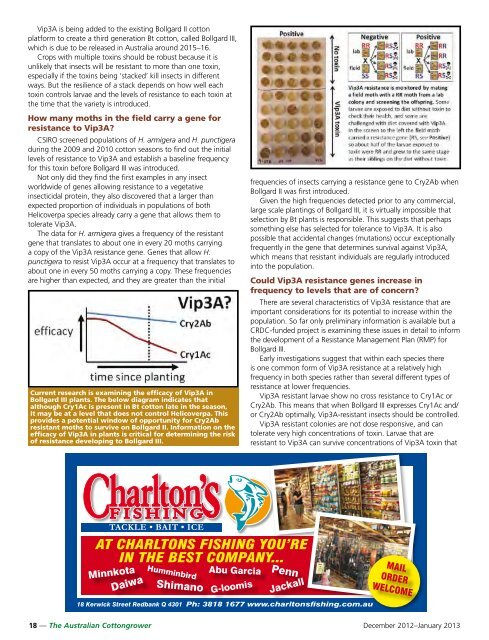cotton - Greenmount Press
cotton - Greenmount Press
cotton - Greenmount Press
You also want an ePaper? Increase the reach of your titles
YUMPU automatically turns print PDFs into web optimized ePapers that Google loves.
Vip3A is being added to the existing Bollgard II <strong>cotton</strong><br />
platform to create a third generation Bt <strong>cotton</strong>, called Bollgard III,<br />
which is due to be released in Australia around 2015–16.<br />
Crops with multiple toxins should be robust because it is<br />
unlikely that insects will be resistant to more than one toxin,<br />
especially if the toxins being ‘stacked’ kill insects in different<br />
ways. But the resilience of a stack depends on how well each<br />
toxin controls larvae and the levels of resistance to each toxin at<br />
the time that the variety is introduced.<br />
How many moths in the field carry a gene for<br />
resistance to Vip3A<br />
CSIRO screened populations of H. armigera and H. punctigera<br />
during the 2009 and 2010 <strong>cotton</strong> seasons to find out the initial<br />
levels of resistance to Vip3A and establish a baseline frequency<br />
for this toxin before Bollgard III was introduced.<br />
Not only did they find the first examples in any insect<br />
worldwide of genes allowing resistance to a vegetative<br />
insecticidal protein, they also discovered that a larger than<br />
expected proportion of individuals in populations of both<br />
Helicoverpa species already carry a gene that allows them to<br />
tolerate Vip3A.<br />
The data for H. armigera gives a frequency of the resistant<br />
gene that translates to about one in every 20 moths carrying<br />
a copy of the Vip3A resistance gene. Genes that allow H.<br />
punctigera to resist Vip3A occur at a frequency that translates to<br />
about one in every 50 moths carrying a copy. These frequencies<br />
are higher than expected, and they are greater than the initial<br />
Current research is examining the efficacy of Vip3A in<br />
Bollgard III plants. The below diagram indicates that<br />
although Cry1Ac is present in Bt - <strong>cotton</strong> late in the season,<br />
it may be at a level that does not control Helicoverpa. This<br />
provides a potential window of opportunity for Cry2Ab<br />
resistant moths to survive on Bollgard II. Information on the<br />
efficacy of Vip3A in plants is critical for determining the risk<br />
of resistance developing to Bollgard III.<br />
frequencies of insects carrying a resistance gene to Cry2Ab when<br />
Bollgard II was first introduced.<br />
Given the high frequencies detected prior to any commercial,<br />
large scale plantings of Bollgard III, it is virtually impossible that<br />
selection by Bt plants is responsible. This suggests that perhaps<br />
something else has selected for tolerance to Vip3A. It is also<br />
possible that accidental changes (mutations) occur exceptionally<br />
frequently in the gene that determines survival against Vip3A,<br />
which means that resistant individuals are regularly introduced<br />
into the population.<br />
Could Vip3A resistance genes increase in<br />
frequency to levels that are of concern<br />
There are several characteristics of Vip3A resistance that are<br />
important considerations for its potential to increase within the<br />
population. So far only preliminary information is available but a<br />
CRDC-funded project is examining these issues in detail to inform<br />
the development of a Resistance Management Plan (RMP) for<br />
Bollgard III.<br />
Early investigations suggest that within each species there<br />
is one common form of Vip3A resistance at a relatively high<br />
frequency in both species rather than several different types of<br />
resistance at lower frequencies.<br />
Vip3A resistant larvae show no cross resistance to Cry1Ac or<br />
Cry2Ab. This means that when Bollgard III expresses Cry1Ac and/<br />
or Cry2Ab optimally, Vip3A-resistant insects should be controlled.<br />
Vip3A resistant colonies are not dose responsive, and can<br />
tolerate very high concentrations of toxin. Larvae that are<br />
resistant to Vip3A can survive concentrations of Vip3A toxin that<br />
Charltons GrnMnt<strong>Press</strong>.indd 1<br />
TACKLE • BAIT • ICE<br />
AT CHARLTONS FISHING YOU’RE<br />
IN THE BEST COMPANY...<br />
Minnkota<br />
Daiwa<br />
Humminbird<br />
Shimano<br />
Abu Garcia<br />
G-loomis<br />
Penn<br />
Jackall<br />
18 Kerwick Street Redbank Q 4301 Ph: 3818 1677 www.charltonsfishing.com.au<br />
MAIL<br />
ORDER<br />
WELCOME<br />
1/09/2010 11:54:49 PM<br />
18 — The Australian Cottongrower December 2012–January 2013

















